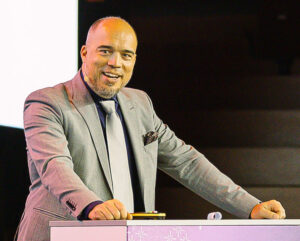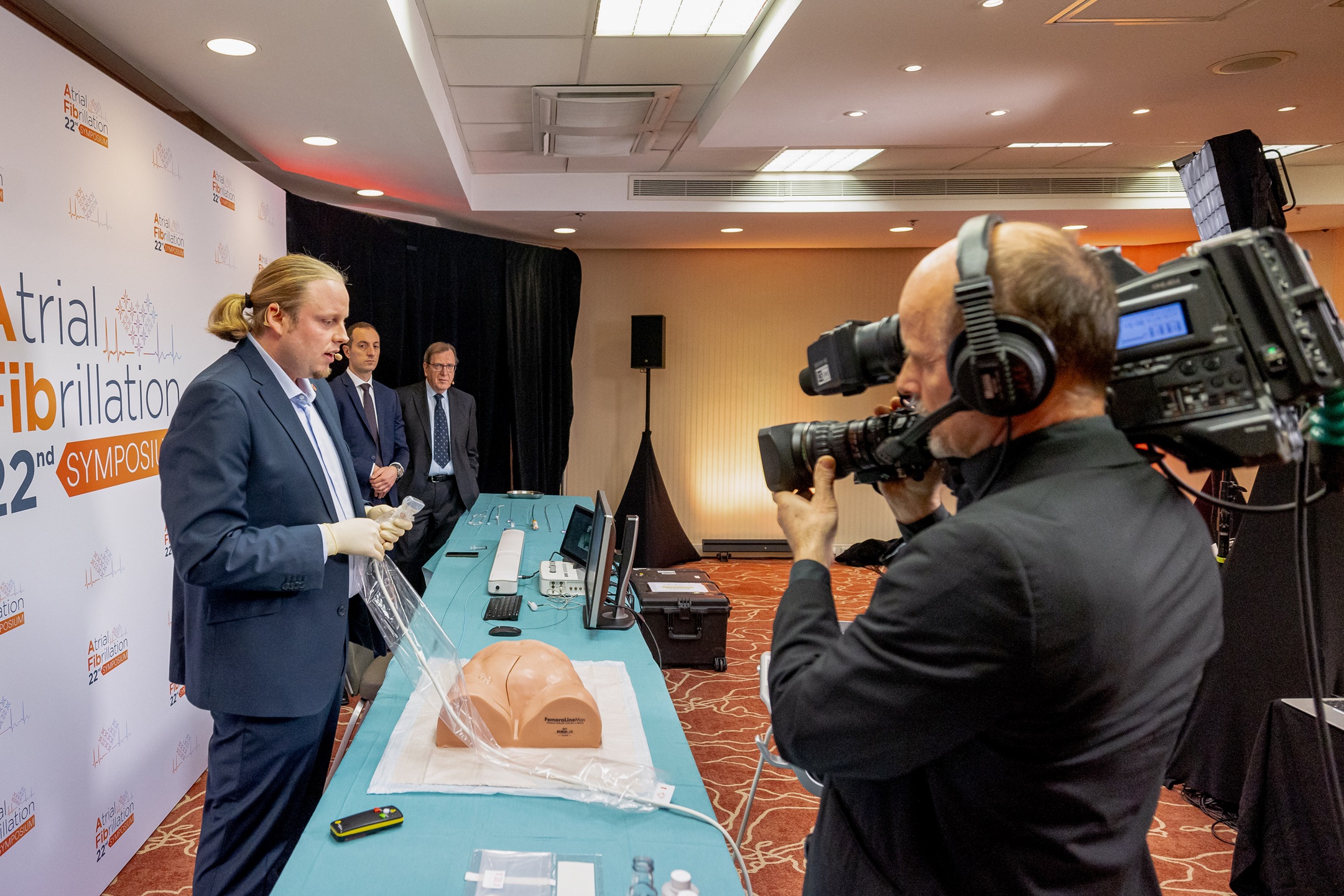This advertorial is sponsored by Biosense Webster

Biosense Webster founded the AFib Symposium in 2002. Now in its 22nd year, the annual event combines practical and scientific sessions on cutting-edge topics relevant to specialists in the treatment of atrial fibrillation (AF).
This year the meeting attracted an audience of more than 800 attendees from around the world across three days, with sessions also beamed simultaneously to a global audience at participating satellite hubs as far afield as Egypt, Kuwait and Mexico.

The evolution of AF treatment since the inception of the AFib Symposium more than two decades ago has been “dramatic”, scientific committee member Philipp Sommer (Heart and Diabetes Center North Rhine-Westphalia, Bad Oeynhausen, Germany) tells Cardiac Rhythm News, commenting that the emergence of pulsed field ablation (PFA)—an important topic of focus at the conference in 2024—may prove to be among the most significant developments in that time.
Whilst questions of the safety and efficacy of PFA were at the forefront of discussions at this year’s event, speakers also touched upon the potential impact this and other advances may have across a number of areas relevant to contemporary electrophysiology practice. Key talking points included the need to improve access to treatment against the backdrop of a growing and ageing population of AF patients, the evolving impact of digital and wearable devices, the need to reduce the use of fluoroscopy to limit harm to the operator, lab team and patient, and how the timing of ablation—particularly when it is deployed early on in the progression of the disease—can optimise outcomes for patients. Looking to provide a holistic overview of these and other hot topics in current practice for the electrophysiology community, the AFib Symposium scientific committee crafted a programme that approaches practice-changing issues from both a practical and scientific standpoint.
The arrival of PFA for the treatment of AF has, for many in the field of cardiac ablation, brought a renewed sense of excitement over the future of catheter-based therapies for the treatment of arrhythmias.
The fact that the 2024 edition of the AFib Symposium (4–6 March, Prague, Czech Republic) came just days after the CE-mark approval for the VARIPULSE™ PFA Platform* (Biosense Webster) added extra significance to discussion of this new technology in a programme that touched on several important developments in the management of AF.
Practical learning

Anchoring the three-day symposium is a practical course with an emphasis on the “everyday” scenarios facing physicians, as described to Cardiac Rhythm News by AFib Symposium’s scientific committee member Sabine Ernst (Royal Brompton and Harefield Hospital, London, UK). Ernst says that this part of the programme is designed particularly with early career physicians in mind. “It’s peer-to-peer education where we are trying to get them to see how to do things.”
The 2024 Symposium opened with an anatomical session focused on regions of the heart that are relevant to AF ablation. With the aid of plastinated heart models, Siew Yen Ho (Royal Brompton and Harefield Hospitals, London, UK), Maxim Didenko (Heart and Diabetes Center North Rhine-Westphalia, Bad Oeynhausen, Germany) and José Angel Cabrera (European University of Madrid, Madrid, Spain) delivered a detailed overview of access to the right atrium with a focus on the proximity to structures such as the pulmonary veins and right phrenic nerve which can be damaged during thermal ablation; the left atrium and infra-atrial connections; and extracardiac structures, highlighting the close relationship between the phrenic nerve and oesophagus.
To supplement their education, delegates were also able to get a hands-on look at mapping, ultrasound and ablation systems through simulated learning sessions that ran parallel to the main agenda, with main stage demonstrations also outlining best practice in technical aspects such as vascular access and transseptal puncture, and strategies aimed at minimising exposure to fluoroscopy.
The practical sessions were punctuated by two “burning issues” debates, the first of which saw parallel arguments for and against the greater use of digital tools such as artificial intelligence (AI) and wearables for the diagnosis and management and AF. Emma Svennberg (Karolinska University Hospital, Solna, Sweden) argued that these tools could widen access to treatment for patients who live outside of urban areas where healthcare is less readily available. In counter to Svennberg, Giuseppe Boriani (Modena Polyclinic University Hospital, Modena, Italy) stressed the importance of physicians not becoming too heavily reliant on machines in their practice. An evenly split audience poll suggested that while AFib Symposium attendees saw the merits of digital tools entering the field, more proof is needed of their benefit and efficacy before a widespread shift towards these methods can be anticipated.

In the second debate, Matthew Wright (Guy’s and St Thomas’ NHS Foundation Trust, London, UK) and Sonia Busch (Heart Center Bodensee, Constance, Germany) went head-to-head on the use of general anaesthesia or conscious sedation during pulmonary vein isolation (PVI). Wright cited the safety, efficacy and comfort for the patient as weighing in the favour of general anaesthesia, whilst Busch noted that conscious and deep sedation are now standard practice in Germany, and argued that this technique is potentially time- and resource-saving for electrophysiologists.
Scientific programme
The scientific programme opened on day two with presentations covering the timing of AF treatment, and speakers highlighted how early treatment of AF can halt the progression of the disease. Svennberg began by discussing treatment strategies based upon how and when AF has been detected. She highlighted the risk of progression to clinical AF among those who have device- or screening-detected AF, and detailed that early intervention, in the form of rhythm control, can prove beneficial.
Jeff Healey (McMaster University, Hamilton, Canada) sought to provide clarity on whether there is a case for the treatment of asymptomatic AF and atrial high-rate episodes (AHREs) with anticoagulation, outlining that with an ageing population and an increasing volume of arrhythmias detected through wearable devices, physicians will need to develop strategies to address these patients. Healey highlighted findings of the ARTESIA trial, looking at whether patients with sub-clinical AF should receive anticoagulation, in which it was shown that the use of apixaban resulted in a lower risk of stroke or systemic embolism than aspirin, but a higher risk of major bleeding.
“At what point should we jump?” was the question at the heart of Jason Andrade’s (Vancouver General Hospital, Vancouver, Canada) presentation covering early AF ablation. AF is not a static entity, Andrade commented, noting that there is a spectrum of disease that begins with preclinical AF and ends in permanent AF. “As time goes on those AF-induced changes in the atrium lead to remodelling and we see that the later phases of the disease can conceptually be thought of as a completely different condition,” he said.
Andrade noted that there are differing levels of risk for outcomes including death, stroke and heart failure hospitalisation for patients with persistent compared to paroxysmal AF, and that progression to persistent AF is associated with outcomes that are worse for patients. “That rationale underpins why we may want to intervene earlier, if we can prevent people from experiencing all of these negative clinical consequences,” he said. Putting forward a case for earlier intervention, Andrade detailed that PVI is an effective treatment for early AF, but recurrence rates become higher among patients with more progressed disease.
Mark O’Neill (St Thomas’ Hospital and King’s College London, London, UK) then discussed when AF ablation does not work, including when it may be too late for the patient to receive treatment or if they are too sick to return to sinus rhythm. Reducing the burden of AF can positively impact patients, O’Neill stated, adding that reducing the time from the diagnosis of AF to the intervention is key to making this happen. O’Neill argued that while technological advances in ablation are important, improved understanding of why ablation may fail in some patients and what can be done to improve outcomes beyond PVI remains paramount.
Women in Ablation Visibility, Equity & Empowerment (WAVEE)
Though advances in AF treatment remain a core focus of the event, topics relating to changes in environment and workflow for the benefit of operators also formed an important component of the 2024 AFib Symposium. This thread ran through the Women in EP WAVEE lunch event, a well-attended session by both female and male delegates, addressing some of the barriers holding back greater representation of women at senior research and societal levels within the field of electrophysiology.

“There’s absolutely no skill that differentiates between gender for electrophysiology,” Ernst tells Cardiac Rhythm News, pointing out the significance of the WAVEE session as what she views as one of the most important parts of the three-day event. Topics raised during the session included the need for mentorship to support women making their first steps in research, and the impact of fluoroscopy, which attendees heard has an added burden upon women as they need to limit their exposure to radiation when they are seeking to start a family—something that is not required for their male colleagues.
“A standard approach should be minimal fluoroscopy, and that is one of the things that we try to train people in,” comments Ernst, underscoring how much importance she places on this concept. “It starts with little things like how you set your X-ray system. It should not be on the default setting, it should be on a low frame rate.”
A deep dive into PFA
The final day of the meeting opened with a deep dive into PFA, including a detailed session outlining the biophysics behind the technology. PFA uses a controlled electric field to ablate cardiac tissue in a relatively selective manner via irreversible electroporation (IRE), and this differs from established technologies such as radiofrequency (RF) or cryoablation which use thermal energy to disrupt abnormal electrical pathways in the heart that cause arrhythmias.
Advocates of PFA believe that the technology has the potential for enhanced safety, as the non-thermal mechanism of ablation does not damage surrounding tissues such as the oesophagus or phrenic nerve.
Though there is excitement over the potential advantages of PFA, some physicians require further convincing that there is a benefit in terms of the efficacy of the technology as compared to the established ablation technologies, and these competing viewpoints featured prominently in the conference programme in sessions that touched on the topic throughout the three days of AFib Symposium.
“After the initial euphoria, there’s always the phase of sobering up,” says Ernst of the process of evaluating new technologies entering the market—alluding to the fact that there has been a great deal of anticipation over the arrival of PFA and its potential impact on the availability and outcomes of AF ablation, a fact that can only truly be gauged once the technology has been used and evaluated in clinical practice.
These points were brought into focus during a debate session in which Boris Schmidt (Cardioangiologisches Centrum Bethanien, Frankfurt, Germany) and Benjamin Berte (Cardiopuls Medical Center, Luzern, Switzerland) put forward contrasting points under the provocative title ‘PFA is better than thermal energies’. Schmidt argued in favour and Berte against.
Schmidt advanced the argument that despite 20 years of workflow improvements there has been little overall change in outcomes through thermal ablation, citing the limitations of the technology as being the underlying cause, and argued that PFA shows promise as having an improved safety profile, whilst also having a shorter learning curve than other ablation modalities.
Berte, on the other hand, stated his view that “many complications are workflow related” and the safety of the technology is not an issue, as well as stressing the importance in continued research and innovation in existing technologies such as RF ablation. Audience polling taken after the debate showed that thermal ablation technologies have yet to be displaced in the eyes of the electrophysiology community, with 64% voting that they retain a preference for using thermal technologies at present.
Cardiac Rhythm News discussed some of these talking points with Jasmina Brooks, President of Biosense Webster, who underlines the importance of weighing up the distinct merits of each individual PFA system.
“PFA is not equal to PFA is not equal to PFA,” Brooks comments. “Not only between two different companies, but also even within the same company, different catheter families are really different. So we’ve said from the very beginning that the clinical evidence is going to be really, really important across the board.”
Brooks also remarks that Biosense Webster still sees RF ablation as having an important role to play in its ablation portfolio, despite the entry of PFA into the arena.
“It’s not black and white, PFA only,” she comments. “Obviously PFA will take a portion of RF cases, for example paroxysmal AF cases, or if you are having a first-time ablation it makes sense to use PFA, but there’s still plenty of room for RF.
“PFA is so early and so new. We’re still learning and right now PFA is very focused on PVI. There are still plenty of other arrhythmias, for example, that haven’t been looked at.”
Reflecting on the legacy of the AFib Symposium and Biosense Webster’s continued backing for the event, Brooks says that the company sees this as an important forum for education and engagement within the community.
“The original reason why this was put in place was to drive that scientific curiosity to present the latest clinical evidence around cardiac ablation on top of collaboration with peers and engagement,” she comments.
“We look at electrophysiologists as a part of our Biosense Webster family, and it’s those relationships and those partnerships that really have shaped our roadmap from the very beginning.”
The AFib Symposium will return in 2025 on 12–14 February in Madrid, Spain.
* VARIPULSE™ PFA platform is available only in Europe and Japan. In the U.S., the VARIPULSE™ Catheter and TRUPULSE™ Generator are currently investigational and are not approved by regulatory authorities. In March 2024, Biosense Webster announced the submission of the VARIUPLSE™ Platform for Premarket Approval Application to the US Food & Drug Administration.
Important information: Prior to use, refer to the instructions for use supplied with this device for indications, contraindications, side effects, warnings and precautions.









